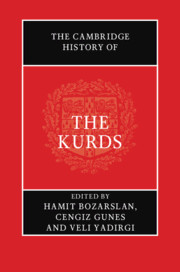Book contents
- The Cambridge History of the Kurds
- The Cambridge History of the Kurds
- Copyright page
- Contents
- Figures
- Maps
- Tables
- Contributors
- Acknowledgements
- Abbreviations
- Additional material
- Introduction
- Part I Historical Legacies
- Part II Regional Political Developments and the Kurds in the Twentieth and Twenty-First Centuries
- Part III Domestic Political Developments and the Kurds in the Twentieth and Twenty-First Centuries
- Part IV Religion and Society
- Part V Kurdish Language
- Part VI Art, Culture and Literature
- Part VII Transversal Dynamics
- 32 A People beyond the State
- 33 Kurdish Transnational Indigeneity
- 34 Kurdish Diaspora
- 35 The Women’s Movement in Kurdistan-Iraq
- 36 A Struggle within a Struggle
- Index
- References
36 - A Struggle within a Struggle
A History of the Kurdistan Women’s Freedom Movement, 1978–2019
from Part VII - Transversal Dynamics
Published online by Cambridge University Press: 13 April 2021
- The Cambridge History of the Kurds
- The Cambridge History of the Kurds
- Copyright page
- Contents
- Figures
- Maps
- Tables
- Contributors
- Acknowledgements
- Abbreviations
- Additional material
- Introduction
- Part I Historical Legacies
- Part II Regional Political Developments and the Kurds in the Twentieth and Twenty-First Centuries
- Part III Domestic Political Developments and the Kurds in the Twentieth and Twenty-First Centuries
- Part IV Religion and Society
- Part V Kurdish Language
- Part VI Art, Culture and Literature
- Part VII Transversal Dynamics
- 32 A People beyond the State
- 33 Kurdish Transnational Indigeneity
- 34 Kurdish Diaspora
- 35 The Women’s Movement in Kurdistan-Iraq
- 36 A Struggle within a Struggle
- Index
- References
Summary
This chapter historically contextualizes the Kurdish Women’s Freedom Movement and analyses the trajectory of its organizational structures from 1987 to the present. It traces how the women’s movement managed to establish its own army (1995) and party (1999) within the PKK, while also establishing the co-chair system and the women’s quota in the political sphere in the early 2000s. The chapter zooms into one crucial moment of contestation between the women and men of the movement: the formation of the Kurdistan Women’s Worker’s Party (Partiya Jinên Karkerên Kurdistanê, PJKK) in 1999. It asks to what extent this and similar internal struggles can help us to gain a more nuanced understand of how the women managed to carve out the spaces for autonomous organizing within the wider movement, how the liberation of women came to feature so prominently in the movement’s ideology and how this speaks to ongoing debates around nationalism and feminism. The chapter also highlights some of the tensions and contradictions that emerge between the claim to liberation and the clear framework around the ‘free woman’.
Keywords
- Type
- Chapter
- Information
- The Cambridge History of the Kurds , pp. 893 - 919Publisher: Cambridge University PressPrint publication year: 2021
References
- 1
- Cited by

